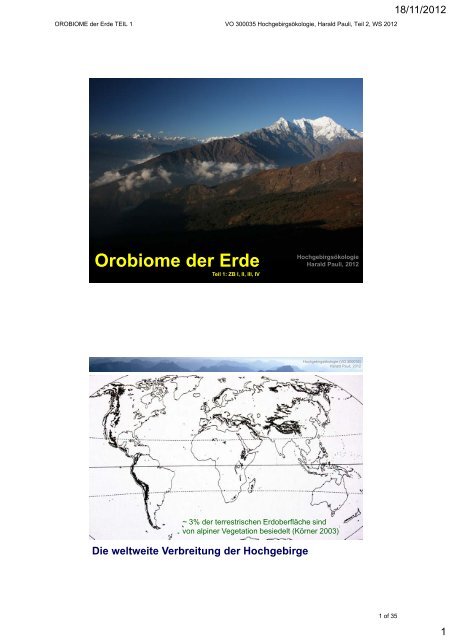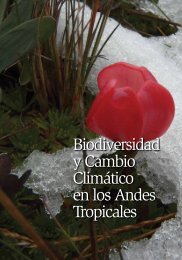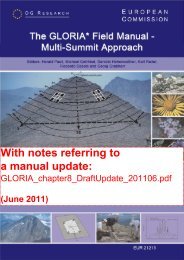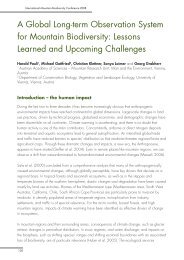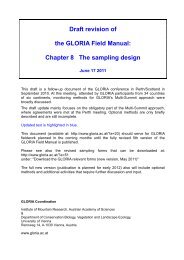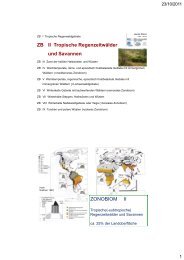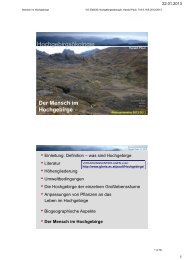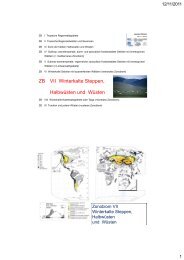Orobiome der Erde
Orobiome der Erde
Orobiome der Erde
Erfolgreiche ePaper selbst erstellen
Machen Sie aus Ihren PDF Publikationen ein blätterbares Flipbook mit unserer einzigartigen Google optimierten e-Paper Software.
18/11/2012<br />
OROBIOME <strong>der</strong> <strong>Erde</strong> TEIL 1 VO 300035 Hochgebirgsökologie, Harald Pauli, Teil 2, WS 2012<br />
<strong>Orobiome</strong> <strong>der</strong> <strong>Erde</strong><br />
Teil 1: ZB I, II, III, IV<br />
Hochgebirgsökologie<br />
Harald Pauli, 2012<br />
Hochgebirgsökologie (VO 300035)<br />
Harald Pauli, 2012<br />
~ 3% <strong>der</strong> terrestrischen Erdoberfläche sind<br />
von alpiner Vegetation besiedelt (Körner 2003)<br />
Die weltweite Verbreitung <strong>der</strong> Hochgebirge<br />
1 of 35<br />
1
18/11/2012<br />
OROBIOME <strong>der</strong> <strong>Erde</strong> TEIL 1 VO 300035 Hochgebirgsökologie, Harald Pauli, Teil 2, WS 2012<br />
Z O N O B I O M E d e r E R D E<br />
ZB I Tropische Regenwaldgebiete<br />
ZB II Tropische Regenzeitwäl<strong>der</strong> und Savannen<br />
TROPEN<br />
ZB III Zone <strong>der</strong> heißen Halbwüsten und Wüsten<br />
ZB IV Mediterranes Zonobiom (Winterfeuchte Subtropen)<br />
ZB V Immerfeuchte Subtropen (Lorbeerwäl<strong>der</strong>) und<br />
temperate Regenwäl<strong>der</strong><br />
ZB VI Nemorales Zonobiom (temperat)<br />
ZB VII Winterkalte Steppen, Halbwüsten und Wüsten<br />
SUB-<br />
TROPEN<br />
MITTEL-<br />
BREITEN<br />
ZB VIII Boreales Zonobiom (winterkalte Nadelwaldgebiete)<br />
BOREAL<br />
ZB IX<br />
Polares Zonobiom (Tundren und polare Wüsten)<br />
POLAR<br />
Hochgebirgsökologie (VO 300035)<br />
Harald Pauli, 2012<br />
Kaukasus<br />
Rocky Mountains<br />
Alpen<br />
Sierra Nevada/<br />
Spanien<br />
Yemen<br />
Ostafrika (Kenya/Tansania)<br />
Himalaya-System<br />
Anden<br />
New Zealand Alps<br />
multizonale Gebirgssysteme<br />
interzonale Gebirge<br />
intrazonale Gebirge<br />
Verbreitung <strong>der</strong> Hochgebirge (ausgenommen Hocharktis und Antarktis)<br />
2 of 35<br />
2
18/11/2012<br />
OROBIOME <strong>der</strong> <strong>Erde</strong> TEIL 1 VO 300035 Hochgebirgsökologie, Harald Pauli, Teil 2, WS 2012<br />
Hochgebirgsökologie (VO 300035)<br />
Harald Pauli, 2012<br />
? (nival)<br />
Holdridge (1978) – ‘Life Zone Concept’<br />
http://upload.wikimedia.org/wikipedia/commons/thumb/c/cb/Lifezones_Pengo.svg/2000px-Lifezones_Pengo.svg.png<br />
(aus Th. Fickert, 2010-10)<br />
Hochgebirgsökologie (VO 300035)<br />
Harald Pauli, 2012<br />
Borneo<br />
(Kinabalu)<br />
(nach<br />
Grabherr 1997)<br />
Nördliche<br />
Anden<br />
(plus<br />
Costa Rica)<br />
Kamerun-Berg<br />
Ostafrika<br />
(Ruwenzori,<br />
Virungas)<br />
Neuguinea<br />
<strong>Orobiome</strong> ZB I<br />
3 of 35<br />
3
18/11/2012<br />
OROBIOME <strong>der</strong> <strong>Erde</strong> TEIL 1 VO 300035 Hochgebirgsökologie, Harald Pauli, Teil 2, WS 2012<br />
Am Äquator<br />
(Zenitalstand<br />
<strong>der</strong> Sonne)<br />
starke<br />
Lufterwärmung<br />
, Verdunstung,<br />
Aufsteigen,<br />
Abkühlung,<br />
Abregnen<br />
atmosphärische<br />
Zirkulation in den Tropen<br />
Kühlere,<br />
trockene Luft<br />
in ca. 15 km<br />
Höhe nach<br />
N/S strömend,<br />
bis ca. 30°N /<br />
S absinkend,<br />
bodennah,<br />
sich wie<strong>der</strong><br />
erwärmend,<br />
zurück zur ITC<br />
Hochgebirgsökologie (VO 300035)<br />
Harald Pauli, 2012<br />
humid-tropisches<br />
Afrika<br />
Orobiom ZB I<br />
Beispiel Ruwenzori<br />
(Uganda/Dem.Rep.Kongo)<br />
Bergwald-Stufe<br />
(1900m)<br />
4 of 35<br />
4
18/11/2012<br />
OROBIOME <strong>der</strong> <strong>Erde</strong> TEIL 1 VO 300035 Hochgebirgsökologie, Harald Pauli, Teil 2, WS 2012<br />
Hochgebirgsökologie (VO 300035)<br />
Harald Pauli, 2012<br />
Orobiom ZB I<br />
Nebelwald-Stufe<br />
(3100m)<br />
Beispiel Ruwenzori<br />
(Uganda/Dem.Rep.Kongo)<br />
Hagenia abyssinica<br />
Hochgebirgsökologie (VO 300035)<br />
Harald Pauli, 2012<br />
Orobiom ZB I<br />
Beispiel Ruwenzori<br />
(Uganda/Dem.Rep.Kongo)<br />
Ericaceen-Wald<br />
(3400m)<br />
5 of 35<br />
5
18/11/2012<br />
OROBIOME <strong>der</strong> <strong>Erde</strong> TEIL 1 VO 300035 Hochgebirgsökologie, Harald Pauli, Teil 2, WS 2012<br />
Hochgebirgsökologie (VO 300035)<br />
Harald Pauli, 2012<br />
Orobiom ZB I<br />
Beispiel Ruwenzori<br />
(Uganda/Dem.Rep.Kongo)<br />
Afro-alpine Stufe<br />
mit<br />
Riesen-Schopfpflanzen<br />
(Dendrosenecio)<br />
(4000m)<br />
Hochgebirgsökologie (VO 300035)<br />
Harald Pauli, 2012<br />
Orobiom ZB I<br />
Alchemilla argyrophyllum<br />
Helichrysum stuhlmannii<br />
Afro-alpine Stufe<br />
Beispiel Ruwenzori<br />
(Uganda/Dem.Rep.Kongo)<br />
6 of 35<br />
6
18/11/2012<br />
OROBIOME <strong>der</strong> <strong>Erde</strong> TEIL 1 VO 300035 Hochgebirgsökologie, Harald Pauli, Teil 2, WS 2012<br />
Hochgebirgsökologie (VO 300035)<br />
Harald Pauli, 2012<br />
Orobiom ZB I<br />
ganzjährig<br />
Frost<br />
Beispiel Ruwenzori<br />
(Uganda/Dem.Rep.Kongo)<br />
Nivale Stufe<br />
(ca. 4800m)<br />
Hochgebirgsökologie (VO 300035)<br />
Harald Pauli, 2012<br />
Orobiom ZB I<br />
Poa ruwenzorensis, ganzjährig Frost<br />
Beispiel Ruwenzori<br />
(Uganda/Dem.Rep.Kongo)<br />
Kryptogamen-Flur<br />
Nivale Stufe<br />
Gipfel Margherita (5109m)<br />
7 of 35<br />
7
18/11/2012<br />
OROBIOME <strong>der</strong> <strong>Erde</strong> TEIL 1 VO 300035 Hochgebirgsökologie, Harald Pauli, Teil 2, WS 2012<br />
Hochgebirgsökologie (VO 300035)<br />
Harald Pauli, 2012<br />
Páramo-Region<br />
<strong>der</strong><br />
Neo-Tropen<br />
Orobiom<br />
ZB I<br />
Hochgebirgsökologie (VO 300035)<br />
Harald Pauli, 2012<br />
Nebelwald<br />
(ceja de la montaña)<br />
Chirripó, Costa Rica<br />
(2800m)<br />
Orobiom<br />
ZB I<br />
8 of 35<br />
8
18/11/2012<br />
OROBIOME <strong>der</strong> <strong>Erde</strong> TEIL 1 VO 300035 Hochgebirgsökologie, Harald Pauli, Teil 2, WS 2012<br />
Hochgebirgsökologie (VO 300035)<br />
Harald Pauli, 2012<br />
Páramo<br />
Orobiom<br />
ZB I<br />
Bambusfluren<br />
(Chusquea)<br />
Chirripó, Costa Rica<br />
(3300-3800m)<br />
Hochgebirgsökologie (VO 300035)<br />
Harald Pauli, 2012<br />
Orobiom<br />
ZB I<br />
Bambusfluren<br />
(Chusquea)<br />
humid-tropische Anden<br />
Chingaza (Kolumbien)<br />
(3700m)<br />
Páramo<br />
9 of 35<br />
9
18/11/2012<br />
OROBIOME <strong>der</strong> <strong>Erde</strong> TEIL 1 VO 300035 Hochgebirgsökologie, Harald Pauli, Teil 2, WS 2012<br />
Hochgebirgsökologie (VO 300035)<br />
Harald Pauli, 2012<br />
Orobiom ZB I<br />
Páramo<br />
Riesen-Schopfpflanzen<br />
(Espeletia)<br />
humid-tropische Anden<br />
Sierra Nevada del Cocuy<br />
(Kolumbien)<br />
(3950m)<br />
Hochgebirgsökologie (VO 300035)<br />
Harald Pauli, 2012<br />
Orobiom ZB I<br />
Ritacuba Blanco<br />
Nival-Stufe<br />
> 5000m<br />
humid-tropische Anden<br />
Sierra Nevada del Cocuy<br />
(Kolumbien)<br />
10 of 35<br />
10
18/11/2012<br />
OROBIOME <strong>der</strong> <strong>Erde</strong> TEIL 1 VO 300035 Hochgebirgsökologie, Harald Pauli, Teil 2, WS 2012<br />
Hochgebirgsökologie (VO 300035)<br />
Harald Pauli, 2012<br />
Mexiko-Guatemala<br />
Äthiopien<br />
Himalaya<br />
zentrale Anden<br />
östl. Ostafrika<br />
(Mt. Elgon, Mt. Kenya<br />
Kilimajaro)<br />
(aus Grabherr 1997)<br />
<strong>Orobiome</strong> ZB II<br />
Sonnenposition<br />
und<br />
Jahreszeiten<br />
(nach Jones et al. 1999, Rev. of Geophysics)<br />
klett.de, terra-online<br />
Äquator und Wendekreise<br />
http://de.wikipedia.org/wiki/Jahreszeit<br />
11 of 35<br />
11
18/11/2012<br />
OROBIOME <strong>der</strong> <strong>Erde</strong> TEIL 1 VO 300035 Hochgebirgsökologie, Harald Pauli, Teil 2, WS 2012<br />
Temperatur und<br />
globale atmosphärische<br />
Zirkulation<br />
im Nord-Winter<br />
südl. des Äquators<br />
Innertropische<br />
Konvergenz-Zone<br />
(ITCZ)<br />
im Nord-Sommer<br />
nördl. des Äquators<br />
(aus Waliser & Gautier, J. Clim 1993)<br />
Hochgebirgsökologie (VO 300035)<br />
Harald Pauli, 2012<br />
Lobelia<br />
telekii<br />
Orobiom ZB II (bzw. Zonoökoton I/II)<br />
Beispiel Mt. Elgon<br />
(Uganda/Kenya)<br />
Dendrosenecio<br />
(4100m)<br />
Lobelia rhynchopetala<br />
(3600m)<br />
Beispiel Bale Mts.<br />
Äthiopien<br />
12 of 35<br />
12
18/11/2012<br />
OROBIOME <strong>der</strong> <strong>Erde</strong> TEIL 1 VO 300035 Hochgebirgsökologie, Harald Pauli, Teil 2, WS 2012<br />
Klimavielfalt, Klimawandel und Klimafolgen<br />
in den tropischen Anden<br />
Die Klimadifferenzierung und ihre Ursachen in den tropischen Anden<br />
Michael Richter (Erlangen)<br />
Anden<br />
0°S<br />
Passate bzw.<br />
Urpassat<br />
hohe<br />
Regenmenge<br />
Regenschatten<br />
kontinentaler<br />
low level jet<br />
verstärkte<br />
Subsidenz<br />
Cuyo-<br />
Tief<br />
diagonale Trockenachse<br />
30°S<br />
langlebiges Hoch<br />
Feuchte und trockene<br />
Sektoren entlang <strong>der</strong> Anden<br />
Steigungsregen<br />
Regenschatten<br />
60°S<br />
120°W<br />
90°W 60°W 30°W<br />
R. Garreaud 2009<br />
Klimavielfalt, Klimawandel und<br />
Klimafolgen<br />
in den tropischen Anden<br />
Die Klimadifferenzierung und<br />
ihre Ursachen in den<br />
tropischen Anden<br />
Abb.:<br />
Michael Richter<br />
(Erlangen)<br />
Steigungsregen<br />
Feucht-<br />
Puna<br />
(Cordillera<br />
Blanca, Peru)<br />
Trocken-<br />
Puna<br />
(Sajama,<br />
Bolivien)<br />
Ost-West-<br />
Gradient an <strong>der</strong><br />
Anden-<br />
Ostabdachung<br />
Nord-<br />
Argentiniens<br />
13 of 35<br />
13
OROBIOME <strong>der</strong> <strong>Erde</strong> TEIL 1 VO 300035 Hochgebirgsökologie, Harald Pauli, Teil 2, WS 2012<br />
18/11/2012<br />
Hochgebirgsökologie (VO 300035)<br />
Harald Pauli, 2012<br />
Orobiom ZB II<br />
Feucht-Puna<br />
Beispiel für tropisch saisonale<br />
semihumide Anden<br />
Cordillera Blanca<br />
(Peru)<br />
(4700m)<br />
Hochgebirgsökologie (VO 300035)<br />
Harald Pauli, 2012<br />
Orobiom ZB II<br />
Beispiel für tropisch saisonale<br />
semihumide Anden<br />
Cordillera Blanca<br />
(Peru)<br />
(4200m)<br />
Puya raimondii<br />
Feucht-Puna<br />
14 of 35<br />
14
18/11/2012<br />
OROBIOME <strong>der</strong> <strong>Erde</strong> TEIL 1 VO 300035 Hochgebirgsökologie, Harald Pauli, Teil 2, WS 2012<br />
Hochgebirgsökologie (VO 300035)<br />
Harald Pauli, 2012<br />
Festuca orthophylla<br />
Trocken-Puna<br />
Beispiel für tropisch saisonale<br />
semiaride Anden<br />
Sajama<br />
(Bolivien)<br />
(4200m)<br />
Orobiom ZB II<br />
Polylepis tarapacana<br />
Pycnophyllum<br />
Trocken-Puna<br />
Azorella compacta<br />
Beispiel für tropisch saisonale<br />
semiaride Anden<br />
Sajama<br />
(Bolivien)<br />
(4800m)<br />
15 of 35<br />
15
18/11/2012<br />
OROBIOME <strong>der</strong> <strong>Erde</strong> TEIL 1 VO 300035 Hochgebirgsökologie, Harald Pauli, Teil 2, WS 2012<br />
Gradient an <strong>der</strong> Anden-Ostabdachung (Nord-Argentinien)<br />
Quebracho blanco<br />
(Aspidosperma quebracho-blanco,<br />
Apocynaceae)<br />
Verschiedene Fabaceen-Gehölze<br />
(Prosopis, Acacia, Caesalpinia)<br />
Argentinien<br />
Semi-ari<strong>der</strong> Chaco-Buschwald (800m)<br />
(Ebene bis Andenrand)<br />
Gradient an <strong>der</strong> Anden-Ostabdachung (Nord-Argentinien)<br />
Bromeliaceae<br />
Argentinien<br />
Östlichste Anden-Vorketten<br />
Tropischer Bergnebelwald<br />
(Parque Nacional Calilegua, 1000m)<br />
16 of 35<br />
16
18/11/2012<br />
OROBIOME <strong>der</strong> <strong>Erde</strong> TEIL 1 VO 300035 Hochgebirgsökologie, Harald Pauli, Teil 2, WS 2012<br />
Gradient an <strong>der</strong> Anden-Ostabdachung (Nord-Argentinien)<br />
Östliche Hoch-Anden<br />
Trocken-Puna<br />
(Fila de Acay, 4600m)<br />
Argentinien<br />
Gradient an <strong>der</strong> Anden-Ostabdachung (Nord-Argentinien)<br />
Anden-Fauna<br />
Vicuña<br />
(Wildform des Alpaca)<br />
Östliche Hoch-Anden<br />
Trocken-Puna<br />
(Fila de Acay, 4500m)<br />
Guanaco<br />
(Wildform des Lama)<br />
17 of 35<br />
17
18/11/2012<br />
OROBIOME <strong>der</strong> <strong>Erde</strong> TEIL 1 VO 300035 Hochgebirgsökologie, Harald Pauli, Teil 2, WS 2012<br />
Hochgebirgsökologie (VO 300035)<br />
Harald Pauli, 2012<br />
Orobiom ZB II<br />
Himalaya<br />
1578mm<br />
(442m)<br />
4792mm<br />
(1642m)<br />
2586mm<br />
(2742m)<br />
1079mm<br />
(2384m)<br />
170mm<br />
(3705m)<br />
(nach Miehe 1991)<br />
N<br />
Indien<br />
Nepal<br />
Tibet<br />
ZB II<br />
ZB VII<br />
(Oktober 2002)<br />
Orobiom ZB II<br />
Himalaya<br />
(ca. 1800m)<br />
Dunche, Nepal<br />
bei Tangmai, SE-Tibet<br />
Bergwald <strong>der</strong> feuchten Himalaya-S-Abdachung<br />
18 of 35<br />
18
OROBIOME <strong>der</strong> <strong>Erde</strong> TEIL 1 VO 300035 Hochgebirgsökologie, Harald Pauli, Teil 2, WS 2012<br />
18/11/2012<br />
Orobiom ZB II<br />
Himalaya<br />
(ca. 3500m)<br />
Koniferen-Wäl<strong>der</strong> mit Rhododendron; Nepal<br />
Hochgebirgsökologie (VO 300035)<br />
Harald Pauli, 2012<br />
Orobiom ZB II<br />
Himalaya<br />
(4600m)<br />
Hengduan Shan, Ost-Himalaya<br />
NW-Yünnan, China (Juli 2005)<br />
feuchter Sommer-Monsun<br />
in <strong>der</strong> alpinen Stufe<br />
Rheum nobile<br />
19 of 35<br />
19
OROBIOME <strong>der</strong> <strong>Erde</strong> TEIL 1 VO 300035 Hochgebirgsökologie, Harald Pauli, Teil 2, WS 2012<br />
18/11/2012<br />
Himalaya<br />
(4850m)<br />
Hochgebirgsökologie (VO 300035)<br />
Harald Pauli, 2012<br />
Orobiom ZB II<br />
Hengduan Shan, Ost-Himalaya<br />
NW-Yünnan, China (Juli 2005)<br />
Arenaria polytrichoides<br />
Rhodiola crenulata<br />
Hochgebirgsökologie (VO 300035)<br />
Harald Pauli, 2012<br />
Orobiom ZB II<br />
Himalaya<br />
Gosain-Kund, Nepal (4500m)<br />
nach W Annapurna, Manaslu<br />
(24. Nov. 2008)<br />
20 of 35<br />
20
OROBIOME <strong>der</strong> <strong>Erde</strong> TEIL 1 VO 300035 Hochgebirgsökologie, Harald Pauli, Teil 2, WS 2012<br />
18/11/2012<br />
Hochgebirgsökologie (VO 300035)<br />
Harald Pauli, 2012<br />
Orobiom ZB II<br />
Subnivale / nivale / aeolische Stufe<br />
Himalaya, Langtang-Lirung, Nepal (7234m)<br />
(23. Nov. 2008)<br />
Hochgebirgsökologie (VO 300035)<br />
Harald Pauli, 2012<br />
Zentral-Sahara:<br />
Hoggar,<br />
Tibesti<br />
Jemen<br />
(nach<br />
Grabherr 1997)<br />
Südl.<br />
Zentral-Anden<br />
(Süd-Peru, N-Chile)<br />
<strong>Orobiome</strong> ZB III<br />
21 of 35<br />
21
18/11/2012<br />
OROBIOME <strong>der</strong> <strong>Erde</strong> TEIL 1 VO 300035 Hochgebirgsökologie, Harald Pauli, Teil 2, WS 2012<br />
Orobiom ZB III<br />
in den Anden<br />
Hochgebirgsökologie (VO 300035)<br />
Harald Pauli, 2012<br />
Nie<strong>der</strong>schlagsprofil<br />
südl. Zentral-Anden<br />
Michael Richter, unveröff.<br />
Orobiom ZB III<br />
Atacama-Anden, Llullaillaco, 6739m<br />
Hochgebirgsökologie (VO 300035)<br />
Harald Pauli, 2012<br />
0-3000m: vegetationslose Wüste<br />
3000-3500m: Strauch- und Sukkulenten-Halbwüste<br />
3500-4200m: Trockenpuna<br />
4200-5000m: andine Gras- und Polsterfluren (höchste Deckung bei 4250m)<br />
> 5000m: subnivale Frostschuttzone<br />
bis in die unvergletscherte Gipfelregion<br />
(nach Michael Richter 1996)<br />
22 of 35<br />
22
18/11/2012<br />
OROBIOME <strong>der</strong> <strong>Erde</strong> TEIL 1 VO 300035 Hochgebirgsökologie, Harald Pauli, Teil 2, WS 2012<br />
Hochgebirgsökologie (VO 300035)<br />
Harald Pauli, 2012<br />
Jahrestemp.-Mittel und Nie<strong>der</strong>schlag:<br />
1020m (Station Bardai): 23,6°C<br />
1,8-19mm<br />
2450m (Trou au Natron): 13,5°C<br />
9,0-190mm<br />
Orobiom ZB III<br />
Tibesti (3415m)<br />
(Zentral-Sahara, Tschad)<br />
Trou au Natron, © R. Mazur<br />
Nie<strong>der</strong>schlag höhenwärtig zunehmend,<br />
oben aber baumfrei – es fehlen frostresistente<br />
Arten<br />
Gehölze in Schluchten (zB. Erica arborea)<br />
Sierra Nevada<br />
(Kalifornien)<br />
(nach Grabherr<br />
1997)<br />
Mittelmeer-Raum:<br />
Atlas, Sierra Nevada,<br />
Ätna, Griech. Gebirge,<br />
Taurus, Elburs<br />
Medit. Anden<br />
(Mittel-Chile)<br />
<strong>Orobiome</strong> ZB IV<br />
23 of 35<br />
23
18/11/2012<br />
OROBIOME <strong>der</strong> <strong>Erde</strong> TEIL 1 VO 300035 Hochgebirgsökologie, Harald Pauli, Teil 2, WS 2012<br />
Hochgebirgsökologie (VO 300035)<br />
Harald Pauli, 2012<br />
Orobiom ZB IV<br />
Sierra Nevada – Kalifornien<br />
Hochgebirgsökologie (VO 300035)<br />
Harald Pauli, 2012<br />
Oxyria<br />
digyna<br />
Orobiom ZB IV<br />
Sierra Nevada – Kalifornien<br />
Pinus albicaulis<br />
(bei 3800m)<br />
24 of 35<br />
24
18/11/2012<br />
OROBIOME <strong>der</strong> <strong>Erde</strong> TEIL 1 VO 300035 Hochgebirgsökologie, Harald Pauli, Teil 2, WS 2012<br />
Hochgebirgsökologie (VO 300035)<br />
Harald Pauli, 2012<br />
Polemonium eximium<br />
Mt. Lamarck, 4090m<br />
(subnivale Stufe)<br />
Orobiom ZB IV<br />
Hulsea algida<br />
Sierra Nevada – Kalifornien<br />
Höhenzonierung im Mittelmeergebiet<br />
Hochgebirgsökologie<br />
Harald Pauli, 2011<br />
Orobiom ZB IV<br />
Meter<br />
2000<br />
Tanne -<br />
(Schwarz)-Kiefer<br />
1500<br />
Buche<br />
und/o<strong>der</strong><br />
1000<br />
laubabwerfen<strong>der</strong><br />
Mischwald<br />
500<br />
Macchie<br />
Garigue (W-Mediterraneis)<br />
Phrygana (O-Mediterraneis)<br />
Stein- und<br />
Kermeseiche,<br />
Korkeiche<br />
Küste<br />
Oliven-Zone (heißes, trockenes eu-mediterranes Klima)<br />
25 of 35<br />
25
18/11/2012<br />
OROBIOME <strong>der</strong> <strong>Erde</strong> TEIL 1 VO 300035 Hochgebirgsökologie, Harald Pauli, Teil 2, WS 2012<br />
Mediterrane Waldgrenzen<br />
Hochgebirgsökologie (VO 300035)<br />
Harald Pauli, 2012<br />
Orobiom ZB IV<br />
v<br />
v<br />
Korsika<br />
Sierra Nevada W-Taurus<br />
Hoher Atlas Kreta (Lefka Ori)<br />
Elburs<br />
Mediterrane Waldgrenzen<br />
Orobiom ZB IV<br />
Elburs Süd-Seite, Iran<br />
3450m<br />
26 of 35<br />
26
18/11/2012<br />
OROBIOME <strong>der</strong> <strong>Erde</strong> TEIL 1 VO 300035 Hochgebirgsökologie, Harald Pauli, Teil 2, WS 2012<br />
Mediterrane Waldgrenzen<br />
Orobiom ZB IV<br />
Elburs Nord-Seite, Iran<br />
ca. 2500m (Nie<strong>der</strong>schläge höhenwärts wie<strong>der</strong> abnehmend)<br />
Mediterrane Waldgrenzen<br />
Wald-/Baumgrenze 2000-2200m<br />
Cedrus libani, 2000m<br />
Juniperus excelsa, ca. 2500m<br />
West-Taurus, Türkei<br />
27 of 35<br />
27
18/11/2012<br />
OROBIOME <strong>der</strong> <strong>Erde</strong> TEIL 1 VO 300035 Hochgebirgsökologie, Harald Pauli, Teil 2, WS 2012<br />
Mediterrane Waldgrenzen<br />
Wald-/Baumgrenze bei<br />
~1700m<br />
Lefka Ori, Kreta<br />
Cupressus sempervirens, 1650m<br />
Mediterrane Waldgrenzen<br />
Juniperus thurifera<br />
ca. 2700m<br />
Oukaimedene, Hoher Atlas, Marokko, ca. 3000m<br />
28 of 35<br />
28
18/11/2012<br />
OROBIOME <strong>der</strong> <strong>Erde</strong> TEIL 1 VO 300035 Hochgebirgsökologie, Harald Pauli, Teil 2, WS 2012<br />
Mediterrane Waldgrenzen<br />
Wald-/Baumgrenze bei<br />
1600-1800m<br />
Korsika<br />
Pinus nigra ssp. laricio<br />
Abies alba<br />
Acer pseudoplatanus<br />
Sorbus aucuparia ssp. praemorsa<br />
Alnus alnobetula ssp. suaveolens<br />
nival<br />
subnival<br />
2800-3100m<br />
kryoro-mediterran<br />
> 2900m<br />
subnival<br />
alpin<br />
2100-2800m<br />
subalpin<br />
1800-2100m<br />
montan<br />
ca. 1800m<br />
oro-mediterran<br />
1900-2900m<br />
supra-mediterran<br />
ca. 1900m<br />
alti-mediterran<br />
“natürliche”<br />
Wald- /<br />
Baumgrenze<br />
fehlt<br />
Alpen<br />
(Nie<strong>der</strong>e/Hohe Tauern)<br />
Sierra Nevada<br />
(N-Seite)<br />
29 of 35<br />
29
18/11/2012<br />
OROBIOME <strong>der</strong> <strong>Erde</strong> TEIL 1 VO 300035 Hochgebirgsökologie, Harald Pauli, Teil 2, WS 2012<br />
Starke Fragmentierung<br />
mediterraner<br />
Gebirge<br />
Hochgebirgsökologie (VO 300035)<br />
Harald Pauli, 2012<br />
Europe's mountain<br />
areas (alpine &<br />
open upper<br />
montane forests)<br />
(Nagy et al. 2010, Atlas of<br />
biodiversity risk)<br />
Sierra Nevada (Mediterr. Hochgebirge)<br />
Orobiom ZB IV<br />
Nie<strong>der</strong>schläge mit <strong>der</strong> Höhe zunehmend<br />
Granada (690m) 470 mm<br />
N-Hang (2500m) 700 mm<br />
>3000m 1000-2000 mm<br />
Nie<strong>der</strong>schlag oberhalb 2500m<br />
fast ausschließlich als Schnee<br />
Von Mitte Juni bis Ende August<br />
kaum Nie<strong>der</strong>schlag<br />
(aus Blanca et al. 2001)<br />
30 of 35<br />
30
18/11/2012<br />
OROBIOME <strong>der</strong> <strong>Erde</strong> TEIL 1 VO 300035 Hochgebirgsökologie, Harald Pauli, Teil 2, WS 2012<br />
Orobiom ZB IV<br />
Astragalus granatensis<br />
Dornpolster-Fluren<br />
(supra-med. bis untere oro.-med. Stufe)<br />
Sierra Nevada, N-Seite, 2100m, Juni 1999<br />
Orobiom ZB IV<br />
Vella spinosa<br />
Erinacea anthyllis<br />
Dornpolster-Fluren<br />
(supra-med. bis untere oro.-med. Stufe)<br />
Sierra Nevada,<br />
N-Seite, 2150m,<br />
Juni 2008<br />
31 of 35<br />
31
18/11/2012<br />
OROBIOME <strong>der</strong> <strong>Erde</strong> TEIL 1 VO 300035 Hochgebirgsökologie, Harald Pauli, Teil 2, WS 2012<br />
Ginster-Gürtel<br />
Genista baetica (oro-mediterran)<br />
Sierra Nevada-Ost,<br />
San Juan N-Seite, 2500m,<br />
Juni 1999<br />
Kryoro-mediterrane Stufe<br />
(oberalpin bis subnival ?)<br />
Sierra Nevada,<br />
3300m,<br />
30. Juni 1999<br />
32 of 35<br />
32
18/11/2012<br />
OROBIOME <strong>der</strong> <strong>Erde</strong> TEIL 1 VO 300035 Hochgebirgsökologie, Harald Pauli, Teil 2, WS 2012<br />
Festuca clementei<br />
Erigeron<br />
frigidus<br />
Jasione crispa ssp.<br />
amethystina<br />
Draba hispanica ssp. la<strong>der</strong>oi<br />
Viola crassiuscula<br />
Saxifraga<br />
nevadensis<br />
kryoro-med. Stufe<br />
Arenaria tetraquetra ssp. amabilis Nevadensia purpurea Androsace vandellii<br />
Endemische Arten<br />
3327m<br />
3150m<br />
2255m<br />
2968m<br />
2214m<br />
2778m<br />
Hochschwab, Nordost-Alpen<br />
1910m<br />
1855m<br />
Sierra Nevada<br />
33 of 35<br />
33
18/11/2012<br />
OROBIOME <strong>der</strong> <strong>Erde</strong> TEIL 1 VO 300035 Hochgebirgsökologie, Harald Pauli, Teil 2, WS 2012<br />
Klimawandel – und die Hochlagenflora <strong>der</strong> Sierra Nevada<br />
Höhersteigen <strong>der</strong> Arten<br />
- viele sind bereits jetzt auf die höchste Zone beschränkt<br />
- die meisten sind Lokal-Endmiten<br />
Erwärmungsbedingt früheres Ausapern<br />
- erhöhter Trockenstress<br />
Nachrückende Arten aus tieferen Lagen<br />
- Konkurrenz durch an Trockenheit angepasste Arten<br />
Migrationsbarrieren (z.B. Waldgürtel) fehlen<br />
- Beschleunigter Konkurrenzdruck ?<br />
Klimawandel – und die Hochlagenflora <strong>der</strong> Sierra Nevada<br />
(Verbreitungskarten<br />
aus Blanca et al. 2001)<br />
Festuca<br />
clementei<br />
(30-40000 Indiv.)<br />
Hormathophylla<br />
purpurea<br />
(50-100000 Indiv.)<br />
Artemisia granatensis (
18/11/2012<br />
OROBIOME <strong>der</strong> <strong>Erde</strong> TEIL 1 VO 300035 Hochgebirgsökologie, Harald Pauli, Teil 2, WS 2012<br />
Klimawandel – und die Hochlagenflora <strong>der</strong> Sierra Nevada<br />
Alyssum spinosum<br />
Cerro de los Machos<br />
3325m<br />
Juli 1999<br />
von supra-med. bis kryoro-med.<br />
Alyssum spinosum-Flur am Jebel Siroua, südl. Hoher Atlas, 3200m<br />
35 of 35<br />
35


